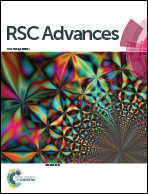An A–π–A′ structural ratiometric fluorescent probe based on benzo[e]indolium for bisulfite and its application in sugar samples and living cells†
Abstract
An A–π–A′ structural ratiometric fluorescent probe 1 bearing a benzo[e]indolium moiety was developed for the detection of HSO3− in PBS buffer solution. HSO3− was expected to react with probe 1 via a Michael addition reaction, causing dramatic changes in its emission spectrum (from 578 nm to 466 nm) and an obvious color change from orange red to blue which could be observed by the naked eye. The reaction could be complete in 30 seconds in the sensing system, and displayed a high selectivity and sensitivity for HSO3− with a detection limit of 15 nM. The practical value of the probe was confirmed for application to detect the level of HSO3− in sugar samples with good recovery and in living cells.
![Graphical abstract: An A–π–A′ structural ratiometric fluorescent probe based on benzo[e]indolium for bisulfite and its application in sugar samples and living cells](/en/Image/Get?imageInfo.ImageType=GA&imageInfo.ImageIdentifier.ManuscriptID=C6RA15605C&imageInfo.ImageIdentifier.Year=2016)

 Please wait while we load your content...
Please wait while we load your content...